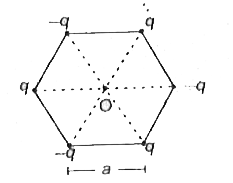Six point charges , each of the same magnitude q, are arranged in different manners as shown in Column II . In each case, a point M and a line PQ passing through M are shown . Let E be the electric field and V be the electric potential at M (potential at infinity is zero ) due to the given charge distribution when it is at rest . Now, the whole system is set into rotation with a constant angular velocity about the line PQ . Let B be the magnetic field at M and μ be the magnetic moment of the system in this condition . Assume each rotating charge to be equivalent to a steady current .

Text Solution
The correct Answer is:[A-PRS ; B-RS ; C-PQT ; D-RS]
[A – P,R,S , B – R, S , C – P, Q, T , D – R, S]
|
Topper's Solved these Questions
- MAGNETIC EFFECTS OF CURRENT Book:VMC MODULES ENGLISHChapter:MAGNETIC EFFECTS OF CURRENT Exercise:JEE Main (Archive)
Explore 75 Videos
- LIQUIDSBook:VMC MODULES ENGLISHChapter:LIQUIDSExercise:JEE ADVANCED (LEVEL -2)
Explore 55 Videos
- MOCK TEST 1Book:VMC MODULES ENGLISHChapter:MOCK TEST 1Exercise:PART I : PHYSICS (SECTION-2)
Explore 10 Videos
Similar Questions
Knowledge Check
Six point charges are placed at the vertices of a regular hexagon of side a as shown. If E represents electric field and V represents electric potential at O then,
 AE = 0 but V ≠ 0BE ≠ 0 but V = 0CE = 0 and V = 0DE ≠ 0 and V ≠ 0
AE = 0 but V ≠ 0BE ≠ 0 but V = 0CE = 0 and V = 0DE ≠ 0 and V ≠ 0Let V be the electric potential at a given point. Then the electric field Ex along x-direction at that point is given by :
A∫∞0VdxBdVdxC−dVdxD−VdVdxLet V be the electric potential at a given point. Then the electric field Ex along x-direction at that point is given by :
A∫∞0VdxBdVdxC−dVdxD−VdVdx
Six point charges are placed at the vertices of a regular hexagon of side a as shown. If E represents electric field and V represents electric potential at O then,

View SolutionDraw a plot showing the variation of (i) electric field (E ) and (ii) electric potential (V) with distance r due to a point charge Q.
View SolutionDraw a plot showing the variation of (i) electric field E, and (ii) electric potential V with distance 'r' due to a point charge Q.
View SolutionThe electric potential at 0.9m from a point charge is +50V. What is the magnitude and sign of the charge ?
View SolutionThe electric field due to a point charge at a distance 6 m from it is 630 N/C. The magnitude of the charge is
View Solution
